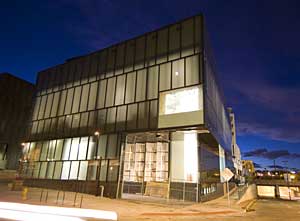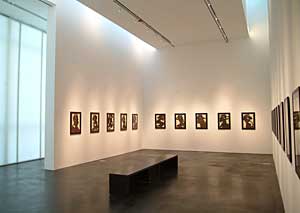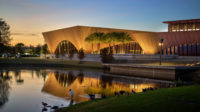For much of its 11-year life, the Museum of Contemporary Art/Denver (MCA) has been overshadowed by the better-known Denver Art Museum. Most recently located in a former fish market downtown, it struggled to attract visitors—despite some well-received shows put together by executive director and chief curator Cydney Payton. But on Sunday the museum will open its new, permanent home: a dark-gray glass box designed by the London-based architect David Adjaye, the rising star’s first public building in the United States.
Click this link to hear a six-minute conversation between MCA Denver architect David Adjaye and RECORD reporter David Hill.
![]()



The new Museum of Contemporary Art in Denver, designed by British architect David Adjaye. Shown in this recent photo, taken while the building was still under construction, the main entrance was among the last elements to be finished in advance of the museum’s opening on October 28 (top). The lobby, as viewed from a second-floor corridor. Although the building lacks an atrium, it does have light wells that extend to skylights in the ceiling (middle). Art work by Chris Ofili hangs in one of six galleries in the new museum (above).
The 27,000-square-foot structure sits on a tight corner lot in Denver’s Central Platte Valley. This former rail yard is now filled with new condos, shops, and parks. Adjaye, known in Europe for his creative use of industrial building materials, employed tinted glass for the museum’s exterior walls but added an interior skin of MonoPan, a translucent material made of woven recycled plastic and used in the fabrication of trailers and storage sheds, among other products. “It was something I encountered at a trade fair of motor cars,” Adjaye says. “I was blown away by this material.” The double-skin facade helps insulate the building while allowing filtered natural light to illuminate the galleries. It’s also one of many sustainable features, which include an evaporative cooling system and radiant floor heating. Visitors who use bicycles or public transportation to access the museum will receive a discount on admission. The MCA is expected to earn a LEED Gold rating.
Visitors enter the building through an opening in its glass exterior wall that leads to a ramp and then a glass door. Inside, there’s no space-wasting atrium, though some vertical spaces reach to skylights on the ceiling. A single, economical elevator serves both visitors and freight. Working creatively on a tight budget of $15.9 million, Adjaye used inexpensive materials—such as concrete, plywood, steel, drywall, and recycled wood—for the interiors. On three floors, he created six self-contained galleries for exhibits, with light-filled “respite corridors”—which he says are designed to give visitors time to pause before moving to the next gallery—running along the MonoPan walls. Strategically placed windows allow views of Denver’s thriving downtown.
Next door to the museum, Adjaye designed a steel-clad house for developer Mark Falcone, an MCA board member who donated land for the new building. Adjaye calls this little-publicized house a “counterpoint” to the museum. An alley between the two structures creates a small public space, though technically it’s a fire lane.
Adjaye has designed a number of houses for artists and collectors, including a studio in the Fort Greene section of Brooklyn—his only other U.S. project. His larger works, such as the Idea Store in London and the Nobel Peace Center in Oslo, Norway, also have a cultural focus. But for someone so closely associated with art and artists, he’s never before designed an art museum. He calls the MCA “incredibly significant, because the art world for me is something that I’ve been invested in.”



Post a comment to this article
Report Abusive Comment